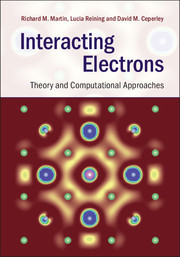Interacting Electrons Theory and Computational Approaches
Langue : Anglais
Auteurs : Martin Richard M., Reining Lucia, Ceperley David M.

This book sets out modern methods of computing properties of materials, including essential theoretical background, computational approaches, practical guidelines and instructive applications.
Recent progress in the theory and computation of electronic structure is bringing an unprecedented level of capability for research. Many-body methods are becoming essential tools vital for quantitative calculations and understanding materials phenomena in physics, chemistry, materials science and other fields. This book provides a unified exposition of the most-used tools: many-body perturbation theory, dynamical mean field theory and quantum Monte Carlo simulations. Each topic is introduced with a less technical overview for a broad readership, followed by in-depth descriptions and mathematical formulation. Practical guidelines, illustrations and exercises are chosen to enable readers to appreciate the complementary approaches, their relationships, and the advantages and disadvantages of each method. This book is designed for graduate students and researchers who want to use and understand these advanced computational tools, get a broad overview, and acquire a basis for participating in new developments.
Preface; Part I. Interacting Electrons: Beyond the Independent-Particle Picture: 1. The many electron problem: introduction; 2. Signatures of electron correlation; 3. Concepts and models for interacting electrons; Part II. Foundations of Theory for Many-Body Systems: 4. Mean fields and auxiliary systems; 5. Correlation functions; 6. Many-body wavefunctions; 7. Particles and quasi-particles; 8. Functionals in many-particle physics; Part III. Many-Body Green's Function Methods: 9. Many-body perturbation theory: expansion in the interaction; 10. Many-body perturbation theory via functional derivatives; 11. The RPA and the GW approximation for the self-energy; 12. GWA calculations in practice; 13. GWA calculations: illustrative results; 14. RPA and beyond: the Bethe-Salpeter equation; 15. Beyond the GW approximation; 16. Dynamical mean field theory; 17. Beyond the single-site approximation in DMFT; 18. Solvers for embedded systems; 19. Characteristic hamiltonians for solids with d and f states; 20. Examples of calculations for solids with d and f states; 21. Combining Green's functions approaches: an outlook; Part IV. Stochastic Methods: 22. Introduction to stochastic methods; 23. Variational Monte Carlo; 24. Projector quantum Monte Carlo; 25. Path integral Monte Carlo; 26. Concluding remarks; Part V. Appendices: A. Second quantization; B. Pictures; C. Green's functions: general properties; D. Matsubara formulation for Green's functions for T ̸= 0; E. Time-ordering, contours, and non-equilibrium; F. Hedin's equations in a basis; G. Unique solutions in Green's function theory; H. Properties of functionals; I. Auxiliary systems and constrained search; J. Derivation of the Luttinger theorem; K. Gutzwiller and Hubbard approaches; References; Index.
Richard M. Martin is Emeritus Professor at the University of Illinois, Urbana-Champaign, and Consulting Professor at Stanford University. He has made extensive contributions to the field of modern electronic structure methods and the theory of interacting electron systems and and he is the author of the companion book Electronic Structure: Basic Theory and Methods.
Lucia Reining is CNRS senior researcher at the Ecole Polytechnique Palaiseau and founding member of the European Theoretical Spectroscopy Facility. Her work covers many-body perturbation theory and time-dependant density functional theory and she is a recipient of the CNRS Silver Medal and a Fellow of the American Physical Society.
David M. Ceperley is Blue Waters Professor at the University of Illinois, Urbana-Champaign, where he has pioneered the quantum Monte Carlo method, including the development of variational, diffusion and path integral Monte Carlo. He is a member of the US National Academy of Sciences and recipient of the Rahman Prize for Computational Physics of the APS and the Feenberg Medal for many-body physics.
Lucia Reining is CNRS senior researcher at the Ecole Polytechnique Palaiseau and founding member of the European Theoretical Spectroscopy Facility. Her work covers many-body perturbation theory and time-dependant density functional theory and she is a recipient of the CNRS Silver Medal and a Fellow of the American Physical Society.
David M. Ceperley is Blue Waters Professor at the University of Illinois, Urbana-Champaign, where he has pioneered the quantum Monte Carlo method, including the development of variational, diffusion and path integral Monte Carlo. He is a member of the US National Academy of Sciences and recipient of the Rahman Prize for Computational Physics of the APS and the Feenberg Medal for many-body physics.
Date de parution : 06-2016
Ouvrage de 840 p.
18.3x25.3 cm
Disponible chez l'éditeur (délai d'approvisionnement : 14 jours).
Prix indicatif 90,79 €
Ajouter au panierThème d’Interacting Electrons :
© 2024 LAVOISIER S.A.S.



